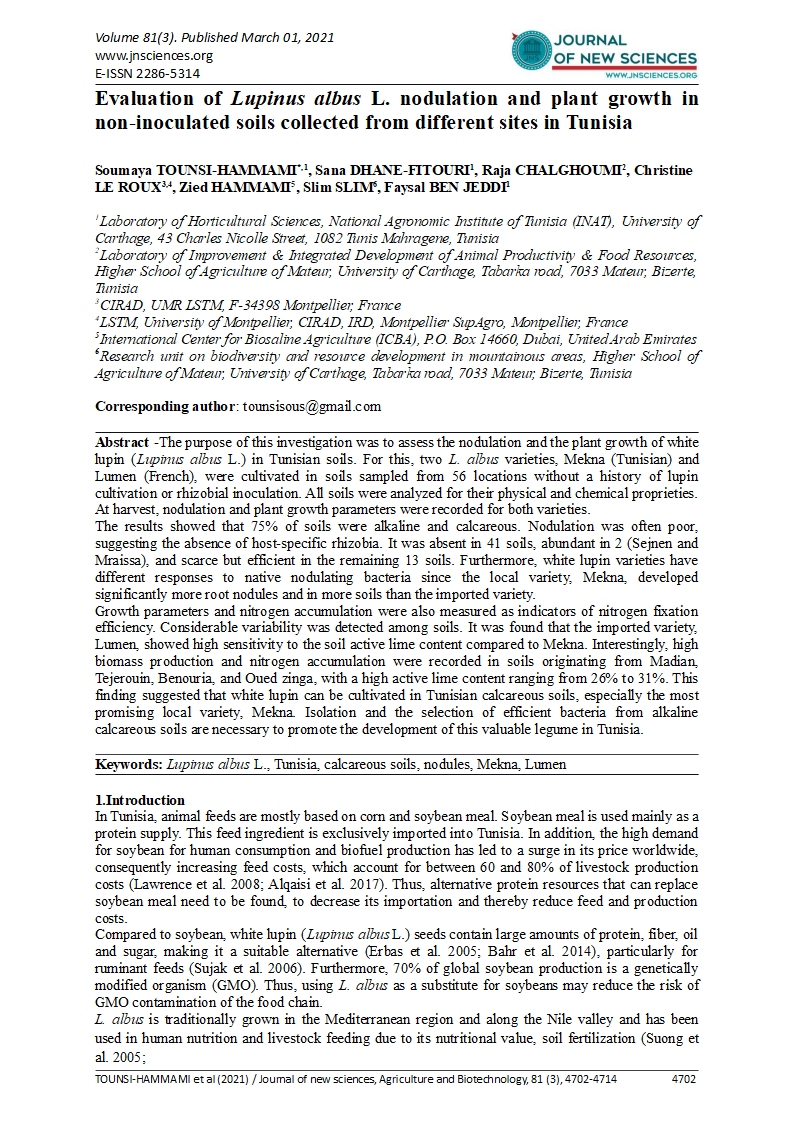

Evaluation of Lupinus albus L. nodulation and plant growth in non-inoculated soils collected from different sites in Tunisia
Soumaya TOUNSI-HAMMAMI1
Sana DHANE-FITOURI1
Raja CHALGHOUMI2
Christine LE ROUX3,4
Zied HAMMAMI5
Slim SLIM6
Faysal BEN JEDDI1
1Laboratory of Horticultural Sciences, National Agronomic Institute of Tunisia (INAT), University of Carthage, 43 Charles Nicolle Street, 1082 Tunis Mahragene, Tunisia
2Laboratory of Improvement & Integrated Development of Animal Productivity & Food Resources, Higher School of Agriculture of Mateur, University of Carthage, Tabarka road, 7033 Mateur, Bizerte, Tunisia
3CIRAD, UMR LSTM, F-34398 Montpellier, France
4LSTM, University of Montpellier, CIRAD, IRD, Montpellier SupAgro, Montpellier, France
5International Center for Biosaline Agriculture (ICBA), P.O. Box 14660, Dubai, United Arab Emirates
6Research unit on biodiversity and resource development in mountainous areas, Higher School of Agriculture of Mateur, University of Carthage, Tabarka road, 7033 Mateur, Bizerte, Tunisia
Abstract -The purpose of this investigation was to assess the nodulation and the plant growth of white lupin (Lupinus albus L.) in Tunisian soils. For this, two L. albus varieties, Mekna (Tunisian) and Lumen (French), were cultivated in soils sampled from 56 locations without a history of lupin cultivation or rhizobial inoculation. All soils were analyzed for their physical and chemical proprieties. At harvest, nodulation and plant growth parameters were recorded for both varieties. The results showed that 75% of soils were alkaline and calcareous. Nodulation was often poor, suggesting the absence of host-specific rhizobia. It was absent in 41 soils, abundant in 2 (Sejnen and Mraissa), and scarce but efficient in the remaining 13 soils. Furthermore, white lupin varieties have different responses to native nodulating bacteria since the local variety, Mekna, developed significantly more root nodules and in more soils than the imported variety. Growth parameters and nitrogen accumulation were also measured as indicators of nitrogen fixation efficiency. Considerable variability was detected among soils. It was found that the imported variety, Lumen, showed high sensitivity to the soil active lime content compared to Mekna. Interestingly, high biomass production and nitrogen accumulation were recorded in soils originating from Madian, Tejerouin, Benouria, and Oued zinga, with a high active lime content ranging from 26% to 31%. This finding suggested that white lupin can be cultivated in Tunisian calcareous soils, especially the most promising local variety, Mekna. Isolation and the selection of efficient bacteria from alkaline calcareous soils are necessary to promote the development of this valuable legume in Tunisia.
Keywords: Lupinus albus L., Tunisia, calcareous soils, nodules, Mekna, Lumen
